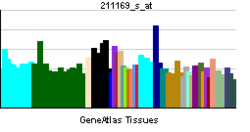PPP1R3A
| PPP1R3A | ||||||
|---|---|---|---|---|---|---|
| Identifiers | ||||||
| Aliases | PPP1R3A, GM, PP1G, PPP1R3, protein phosphatase 1 regulatory subunit 3A | |||||
| External IDs | MGI: 2153588 HomoloGene: 48124 GeneCards: PPP1R3A | |||||
| RNA expression pattern | ||||||
  | ||||||
| More reference expression data | ||||||
| Orthologs | ||||||
| Species | Human | Mouse | ||||
| Entrez | ||||||
| Ensembl | ||||||
| UniProt | ||||||
| RefSeq (mRNA) | ||||||
| RefSeq (protein) | ||||||
| Location (UCSC) | Chr 7: 113.88 – 114.08 Mb | Chr 6: 14.71 – 14.76 Mb | ||||
| PubMed search | [1] | [2] | ||||
| Wikidata | ||||||
| View/Edit Human | View/Edit Mouse |
Protein phosphatase 1 regulatory subunit 3A is an enzyme that in humans is encoded by the PPP1R3A gene.[3][4]
The glycogen-associated form of protein phosphatase-1 (PP1) derived from skeletal muscle is a heterodimer composed of a 37-kD catalytic subunit (MIM 176875) and a 124-kD targeting and regulatory subunit, referred to as PP1G by Hansen et al. (1995). PP1G binds to muscle glycogen with high affinity, thereby enhancing dephosphorylation of glycogen-bound substrates for PP1 such as glycogen synthase (e.g., MIM 138570) and glycogen phosphorylase kinase (e.g., MIM 306000). Phosphorylation at ser46 of the PP1G subunit in response to insulin increases PP1 activity, while phosphorylation at ser65 in response to adrenaline causes dissociation of the catalytic subunit from the G subunit and inhibits glycogen synthesis. Because of these functions, PP1G was postulated to be involved in noninsulin-dependent diabetes mellitus (NIDDM; MIM 125853) and obesity.[supplied by OMIM][4]
References
- ↑ "Human PubMed Reference:".
- ↑ "Mouse PubMed Reference:".
- ↑ Chen YH, Hansen L, Chen MX, Bjorbaek C, Vestergaard H, Hansen T, Cohen PT, Pedersen O (Nov 1994). "Sequence of the human glycogen-associated regulatory subunit of type 1 protein phosphatase and analysis of its coding region and mRNA level in muscle from patients with NIDDM". Diabetes. 43 (10): 1234–41. doi:10.2337/diabetes.43.10.1234. PMID 7926294.
- 1 2 "Entrez Gene: PPP1R3A protein phosphatase 1, regulatory (inhibitor) subunit 3A (glycogen and sarcoplasmic reticulum binding subunit, skeletal muscle)".
Further reading
- Hubbard MJ, Cohen P (1990). "Regulation of protein phosphatase-1G from rabbit skeletal muscle. 1. Phosphorylation by cAMP-dependent protein kinase at site 2 releases catalytic subunit from the glycogen-bound holoenzyme.". Eur. J. Biochem. 186 (3): 701–9. doi:10.1111/j.1432-1033.1989.tb15263.x. PMID 2558013.
- Hansen L, Hansen T, Vestergaard H, et al. (1995). "A widespread amino acid polymorphism at codon 905 of the glycogen-associated regulatory subunit of protein phosphatase-1 is associated with insulin resistance and hypersecretion of insulin". Hum. Mol. Genet. 4 (8): 1313–20. doi:10.1093/hmg/4.8.1313. PMID 7581368.
- Xia J, Scherer SW, Cohen PT, et al. (1998). "A common variant in PPP1R3 associated with insulin resistance and type 2 diabetes". Diabetes. 47 (9): 1519–24. doi:10.2337/diabetes.47.9.1519. PMID 9726244.
- Berrebi-Bertrand I, Souchet M, Camelin JC, et al. (1998). "Biophysical interaction between phospholamban and protein phosphatase 1 regulatory subunit GM". FEBS Lett. 439 (3): 224–30. doi:10.1016/S0014-5793(98)01364-7. PMID 9845327.
- Walker KS, Watt PW, Cohen P (2000). "Phosphorylation of the skeletal muscle glycogen-targeting subunit of protein phosphatase 1 in response to adrenaline in vivo". FEBS Lett. 466 (1): 121–4. doi:10.1016/S0014-5793(99)01771-8. PMID 10648825.
- Hartley JL, Temple GF, Brasch MA (2001). "DNA Cloning Using In Vitro Site-Specific Recombination". Genome Res. 10 (11): 1788–95. doi:10.1101/gr.143000. PMC 310948
 . PMID 11076863.
. PMID 11076863. - Wang G, Qian R, Li Q, et al. (2002). "The association between PPP1R3 gene polymorphisms and type 2 diabetes mellitus". Chin. Med. J. 114 (12): 1258–62. PMID 11793847.
- Savage DB, Agostini M, Barroso I, et al. (2002). "Digenic inheritance of severe insulin resistance in a human pedigree". Nat. Genet. 31 (4): 379–84. doi:10.1038/ng926. PMID 12118251.
- Strausberg RL, Feingold EA, Grouse LH, et al. (2003). "Generation and initial analysis of more than 15,000 full-length human and mouse cDNA sequences". Proc. Natl. Acad. Sci. U.S.A. 99 (26): 16899–903. doi:10.1073/pnas.242603899. PMC 139241
 . PMID 12477932.
. PMID 12477932. - Scherer SW, Cheung J, MacDonald JR, et al. (2003). "Human Chromosome 7: DNA Sequence and Biology". Science. 300 (5620): 767–72. doi:10.1126/science.1083423. PMC 2882961
 . PMID 12690205.
. PMID 12690205. - Hillier LW, Fulton RS, Fulton LA, et al. (2003). "The DNA sequence of human chromosome 7". Nature. 424 (6945): 157–64. doi:10.1038/nature01782. PMID 12853948.
- Lerín C, Montell E, Nolasco T, et al. (2003). "Regulation and function of the muscle glycogen-targeting subunit of protein phosphatase 1 (GM) in human muscle cells depends on the COOH-terminal region and glycogen content". Diabetes. 52 (9): 2221–6. doi:10.2337/diabetes.52.9.2221. PMID 12941760.
- Alcoser SY, Hara M, Bell GI, Ehrmann DA (2004). "Association of the (AU)AT-rich element polymorphism in PPP1R3 with hormonal and metabolic features of polycystic ovary syndrome". J. Clin. Endocrinol. Metab. 89 (6): 2973–6. doi:10.1210/jc.2003-031189. PMID 15181086.
- Gerhard DS, Wagner L, Feingold EA, et al. (2004). "The Status, Quality, and Expansion of the NIH Full-Length cDNA Project: The Mammalian Gene Collection (MGC)". Genome Res. 14 (10B): 2121–7. doi:10.1101/gr.2596504. PMC 528928
 . PMID 15489334.
. PMID 15489334. - Hayashida Y, Goi T, Hirono Y, et al. (2005). "PPP1R3 gene (protein phosphatase 1) alterations in colorectal cancer and its relationship to metastasis". Oncol. Rep. 13 (6): 1223–7. doi:10.3892/or.13.6.1223. PMID 15870946.
- Olsen JV, Blagoev B, Gnad F, et al. (2006). "Global, in vivo, and site-specific phosphorylation dynamics in signaling networks". Cell. 127 (3): 635–48. doi:10.1016/j.cell.2006.09.026. PMID 17081983.